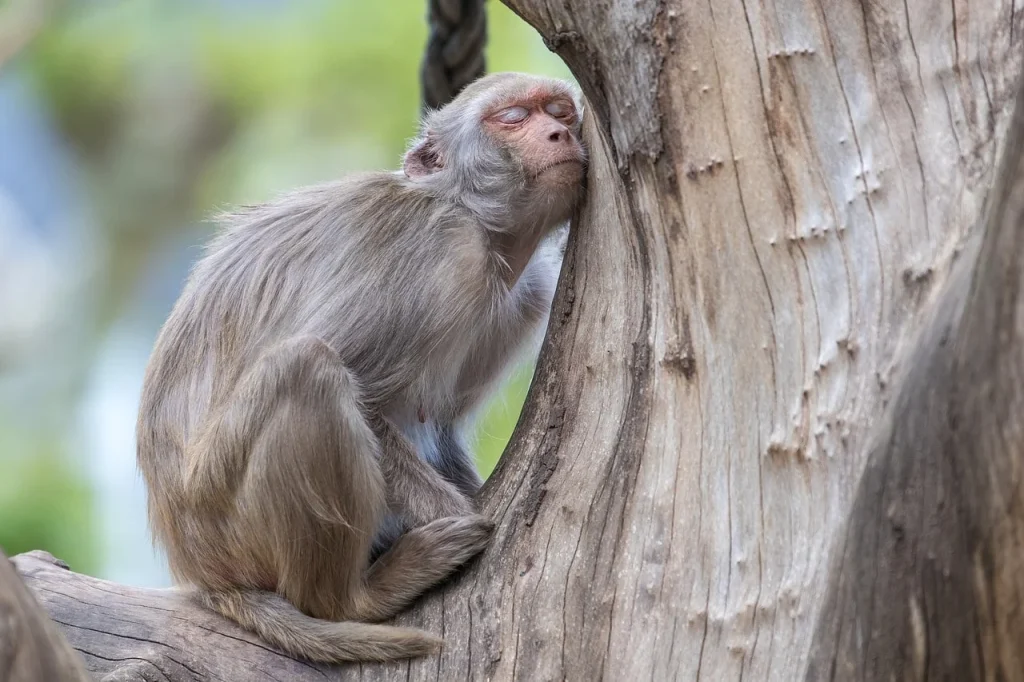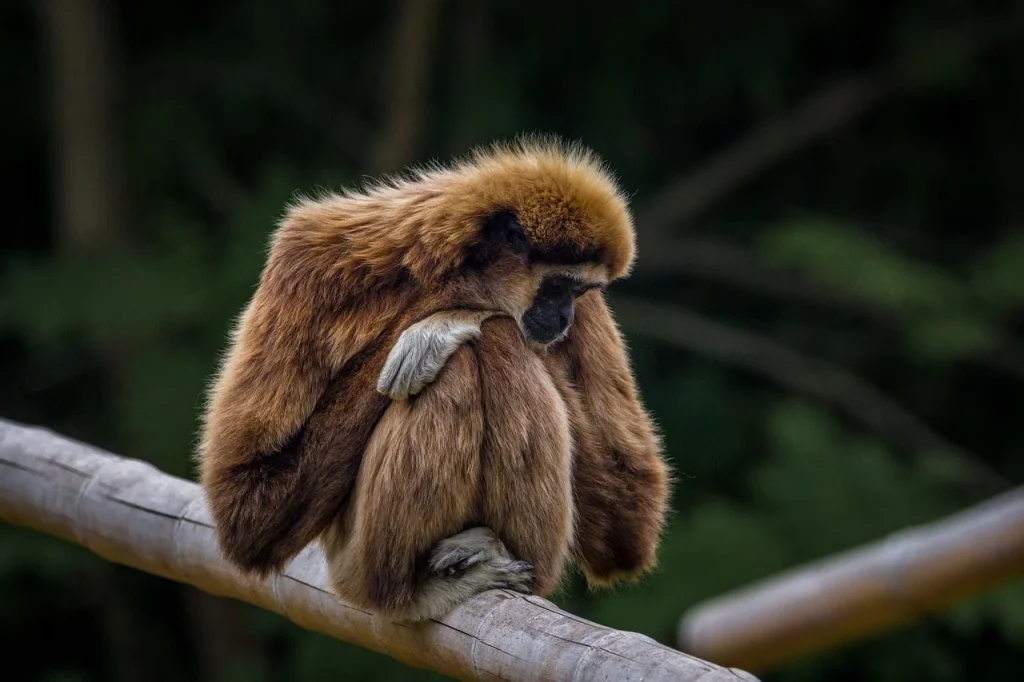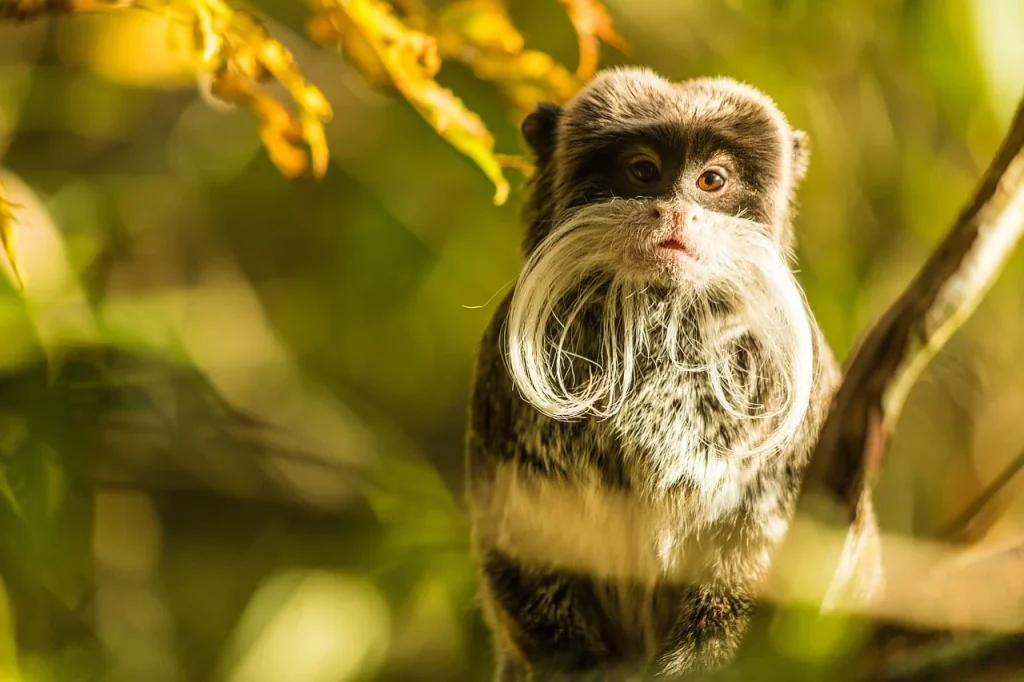What has a tail that can grasp branches, expressive facial features, and a knack for mischief? You guessed it—monkeys! These incredible animals are among the most interesting members of the animal kingdom.
With their diverse species, varying sizes, and intriguing habits, monkeys never fail to surprise and delight us. In this article, we’ll uncover some fun facts about monkeys, shedding light on their lives and the various quirks that make each species special.
Monkeys are superior to men in this: when a monkey looks into a mirror, he sees a monkey.
Malcolm de Chazal
Monkey Facts
Get ready to uncover some amazing facts. Keep an eye out for the quiz at the end of this article because it’s your chance to prove how much you’ve learned!
- Capuchins often use stones to crack open nuts and shellfish, showcasing their tool-using abilities.
- The golden snub-nosed monkey can survive in temperatures that drop below -20 degrees Celsius, thanks to their thick fur.
- Howler monkeys are the loudest of all primates, their calls can be heard up to 3 miles away in dense forests.
- Unlike most primates, spider monkeys have no thumb, an adaptation that helps them swing more effectively from branch to branch.
- The pygmy marmoset, the world’s smallest monkey, weighs just over 100 grams, about as much as a large light bulb.
- Proboscis monkeys have large, fleshy noses that enhance vocal resonances used for communication, particularly in males.
- Mandrills are not just colorful; they are considered the most colorful mammals on Earth due to their distinctive facial and rump coloring.
- The gelada doesn’t climb trees; it’s the only grass-eating primate, spending most of its life on the ground in the Ethiopian highlands.
- Some species are known to wash their food before eating, a behavior observed in Japanese macaques with sweet potatoes.
- The colobus monkey is born with all-white fur and a pink face, which changes color as they mature.
- Tití monkeys are monogamous, forming lifelong bonds with their mates, and are often seen with their tails entwined.
- Aye-ayes use a specialized long middle finger to tap on wood to locate grubs and then extract them, a form of percussive foraging.
- Langurs participate in allomothering, where individuals other than the mother help care for the young.

- When threatened, a baboon will flash its eyelids, which are often brightly colored and can be startling to predators.
- The uakari has a bright red face, an indicator of good health, and potentially helps in choosing a mate.
- Tarsiers have enormous eyes relative to their body size; each eye is as large as their brain.
- Drills are one of Africa’s most endangered primates, with only about 3,000 left in the wild.
- A group of monkeys may be called a troop, barrel, carload, or tribe, depending on their social structure.
- Many species are capable of recognizing themselves in mirrors; this self-awareness test has been passed by some capuchins and other higher primates.
- Night monkeys are the only truly nocturnal group of primates, adapted to life in the dark.
- Vervet monkeys use over 30 different vocalizations to communicate with one another, each with a specific meaning.
- The golden lion tamarin takes its name from its impressive mane, resembling that of the iconic big cat.
- Leaf monkeys get their name from their diet primarily consisting of leafy vegetation, which is difficult to digest and requires a complex stomach.
- When baby macaques are born, they are more mature than most primates and able to cling to their mother immediately after birth.
- Squirrel monkeys have the largest brain-to-body mass ratio of all the primate species, relative to their size.
- Douc langurs are often referred to as ‘costumed apes’ because of their striking appearance.
- Albino individuals, although rare, can occur in several monkey species, exhibiting a complete lack of melanin in their skin and fur.
- Many primates engage in social grooming not just for cleanliness but also to strengthen social bonds and reduce stress.

- The bonnet macaque is known for its permanent smile, caused by the shape of its lips and mouth.
- Woolly monkeys are excellent at leaping, capable of jumping up to 15 feet horizontally between trees.
- Zanzibar red colobus monkeys are found only in Zanzibar and nearby forest islands, making them very geographically specific.
- Emperor tamarins are believed to be named after the German emperor Wilhelm II, due to their distinctive mustaches.
- Black spider monkeys help regrow the rainforest; they are excellent seed dispersers thanks to their messy eating habits.
- Capuchins can learn to use money; researchers have taught them to trade silver discs for treats.
- Lion-tailed macaques spend a significant amount of their time in the upper canopy of tropical rainforests, away from the forest floor.
- The patas monkey is the fastest primate on land, capable of reaching speeds up to 55 kilometers per hour.
- Snub-nosed monkeys are so named because of their distinctive flat noses, which are unlike those of most other primates.
- Bald uakaris are sensitive to malaria; their baldness and bright red faces are indicators of good health in this species.

- Guianan saki monkeys are sometimes called ‘flying monkeys’ because of their incredible ability to leap between trees.
- White-faced sakis exhibit strong sexual dimorphism; males have striking white faces, while females are a plain brown.
- The Rhesus macaque has been invaluable in medical research, contributing to the development of vaccines and other treatments.
- Blue monkeys are not actually blue; their fur appears blue due to the light reflection on their dark grey and olive fur.
- Primates, including orangutans, have been observed using spears to fish, one of the few instances of tool use for hunting in non-humans.
- Gray langurs are considered sacred in several regions of India and often live without fear of human interference.
- De Brazza’s monkeys are so elusive and well-camouflaged that they are often called ‘the ghost monkeys of the forest.’
- Mustached monkeys communicate with a variety of facial expressions, vocalizations, and body postures.
- The howler monkey has an enlarged hyoid bone in its throat that serves as a resonance chamber for its powerful calls.
- Japanese macaques exhibit a variety of cultural behaviors, including bathing together in hot springs during the winter.
- Primate research contributes significantly to our understanding of genetics, behavior, and even human evolution.
- Silvery gibbons are known for their duets; mating pairs sing together in a complex pattern that strengthens their bond and establishes their territory.
Monkey Myths

Now that we’ve explored the facts about monkeys, let’s continue to separate myth from reality. It’s time to uncover the truth behind common misconceptions.
- Monkeys love eating bananas all the time.
While bananas are often enjoyed by monkeys, their natural diet is far more diverse, including fruits, leaves, insects, and even small animals. Excessive consumption of bananas in captivity is not encouraged, as it is not reflective of their natural dietary habits. - All monkeys swing from trees.
Not all monkeys are arboreal (tree-dwelling). Many species, like the baboons, primarily live on the ground and are excellent runners. Tree swinging is typically observed in arboreal species that use their agile movements to navigate forest canopies. - Monkeys are naturally aggressive and dangerous.
They are generally reserved and shy around humans and other potential threats. Aggressive behavior is usually displayed only when they feel threatened or when their territory is invaded. They are more curious than aggressive by nature. - Monkeys can be domesticated like dogs or cats.
Domestication of monkeys is not recommended or feasible on a wide scale. They require complex social interactions, specific diets, and large spaces that mimic their natural habitat, which are difficult to provide in a home environment. - Monkeys communicate only through vocalizations.
Communication is highly sophisticated, involving a combination of vocalizations, facial expressions, body postures, and gestures. This complex system is used not only to communicate with each other but also to express emotions and navigate social dynamics.
Monkey Quotes

I hope you enjoyed the article so far. Let’s continue with some of my favorite quotes. You can always share yours in the comments so I can add them to the list.
A monkey is a visual creature in a universe where the apple doesn’t fall far from the tree.
Alex Shakar
Alex Shakar creatively captures the idea that monkeys, much like humans, are creatures shaped significantly by their immediate environments and perceptions.
He who is bitten by a monkey has a taste of monkeyship.
Peter Abelard
Peter Abelard’s quirky proverb suggests that personal experiences, even those as unusual as being bitten by a monkey, can profoundly affect one’s perspective or behavior.
The higher a monkey climbs, the more you see of its behind.
Joseph Sidwell
This quote by Joseph Sidwell offers a humorous but poignant reminder that the more prominent or exposed a person becomes, the more their flaws and vulnerabilities are revealed.
When a monkey dons a hat, it is still a monkey.
Swahili Proverb
This Swahili Proverb emphasizes the idea that superficial changes do not alter the fundamental nature of a person or thing.
Monkeys are too good for man to be descended from them.
Friedrich Nietzsche
Friedrich Nietzsche wryly comments on human nature by suggesting that monkeys, often seen as lesser beings, actually exhibit qualities superior to those found in humans.
Monkey FAQ

We are one section away from the quiz. Read the FAQs carefully if you want to score a perfect ten.
- Can monkeys swim?
Yes, many monkeys can swim! They usually do so to cross rivers or avoid predators. However, not all species are comfortable in water, and their swimming abilities can vary. - Which monkeys have prehensile tails?
Prehensile tails are mostly found among New World monkeys, which inhabit Central and South America. Some examples include spider monkeys, howler monkeys, and capuchin monkeys. These tails function almost like a fifth limb, helping them grasp and handle objects or hang from branches. - Can monkeys eat chocolate?
They should not eat chocolate. Chocolate contains theobromine, which is toxic to many animals, including monkeys. Consuming chocolate can lead to serious health issues for them. - How do monkeys eat bananas?
They are quite skilled at eating bananas. They typically peel the banana by pinching the bottom end, which splits the skin, and then they pull it back to access the fruit inside. It’s a neat and efficient method! - Can monkeys talk?
They cannot talk like humans. They do not have the vocal cords and brain structure that humans do for complex speech. However, monkeys are capable of communicating using a variety of sounds, gestures, and facial expressions to convey different messages within their groups.
Monkey Trivia

Welcome to our marvelous monkey quiz! If you don’t manage to get any questions right, don’t be surprised if you start finding bananas mysteriously left on your doorstep!
Conclusion
Monkeys are truly impressive creatures, with abilities that exceed climbing trees and swinging from branches. Their emotional depth and social interactions are profound, reminding us of the complexity of nature.
As we reflect on their habits and habitats, it’s our responsibility to ensure their survival and well-being. Imagine a world where we live in harmony with these incredible animals. Till next time, stay curious and explore more. Cheers.


